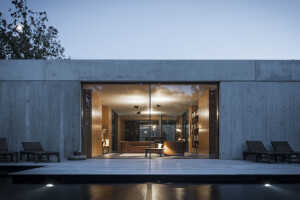The project at 1074 Cardero Street focuses on creating sustainable urban densification in Vancouver. It aims to provide a template and vision for addressing the challenges of offering rental housing for the growing population in the limited urban area of Vancouver’s West End. This project puts forward a strategy for sustainable development and heritage revitalization of the city’s historic fabric while balancing the needs of the “missing middle” in urban housing.
It offers an affordable, mid-density rental housing alternative by way of preservation and carefully considered augmentation of the site. The project aims to address the need for more housing by utilizing the unused space in the city while preserving the historic urban scale of 19th and early 20th-century West End Vancouver.
The Infill abuts the raw urban backdrop of Jepson Young Lane, which runs perpendicular to Cardero Street. At four meters in width, the Infill building at Cardero is one of the narrowest buildings in Vancouver.



This compact square site adjacent to a mini-park included two Class B registered Heritage Houses; the Fleming Residence and the Cardero Street Grocery. The purpose-built mixed-use Cardero Grocery, which anchored the corner site as a commercial hub in the neighbourhood for over 100 years, was a vital aspect of its regeneration, underscoring the importance of preserving our historical landmarks.

Urban densification projects in Vancouver often do not consider the established patterns and refined grain of the city’s remaining grid of historic lots. This project offers an alternative approach to urban densification through the restoration of two historic houses and the addition of a high-performance adjoining infill residence strategically attached to the rear of the site. This project converted three independent dwellings (two 3-bed units + one 2-bed unit) and a CRU to into five independent dwellings + CRU.

The extremely tight site constraints posed a huge challenge to fit additional space into the project and leverage it to make it viable. Additionally, the presence of two large Heritage Houses on the site could have been seen as a limiting factor to some in how the site could be future developed. Our solution was to work with the city and creatively reimagine how we could work with the houses to leverage additional density for the site.
This was achieved by raising and relocating the existing houses forward to capture space in the rear yard.


This allowed us to create a large three-bedroom unit in a former crawl space and to add a bespoke adjoining infill structure.




Where possible, materials from the deconstructed elements of the houses were salvaged or rebuilt in kind. Guided by our Conservation Consultants Donald Luxton & Associates, distinct building elements were catalogued and assessed, carefully dismantled, and stored off-site.


The restoration of original wood siding, columns, dentals, architraves and doors were tested for original 20th-century paint coats. These elements were then meticulously stripped, rehabilitated and primed before being reinstated into the building. The restoration of original wood sash windows and float glass (where possible) was carefully dismantled and rehabilitated using original components in-so-far as possible. The original 100 glazing can still be seen on the majority of the Cardero Street-facing windows.

The units are large, spacious, family-orientated dwellings with their own exterior spaces, making them rather unique and desirable in the West End neighbourhood. It sets a vision for sustainable development and heritage revitalization while balancing the needs of the "missing middle" in urban housing. This project also holds an 85-year rental covenant to further protect the attainability of unique ground-orientated units for the rental market.
The interiors of the restored heritage houses are contemporary in their finishing. The tension between old and new is palpable at bay windows, porches, and other areas where the architectural order of the exterior imprints itself on the modern aesthetic of the interior.




The retention of the corner Commercial Retail Unit (CRU) was a key aspect of this development. It acts as an extension of the public realm, animating the corner site and adjacent parklet, helping to anchor a social hub in the neighbourhood, and contributing to its regeneration. This approach supports the integration of commercial spaces in the residential area, enhancing the livability and community aspects of the neighbourhood.

The two heritage-restored character houses complete the preserved street frontage of Cardero Street. The old Grocery anchors the corner with Jepson-Young Lane. Deep in the site, bridging across the space between the two heritage buildings – the Infill sits stealthily, suggesting an alternative approach to densification in established neighbourhoods.

Kate Fleming was a significant figure in the history of Vancouver’s West End. As one of Vancouver’s first women entrepreneurs, she commissioned the building, opening a grocery on the main floor and living above. Her building was an important anchor for the early 1900s neighborhood. However over the ensuing century, the two houses succumbed to entropy and urban decay. The grocery was no longer in use, and the houses were unremarkable and neglected.
Today, the restored Fleming house, along with its sister building to the north and the sleek modern infill in the adjacent lane, reestablish the importance of this corner. The retail space at the corner of Cardero and Jepson-Young Lane will once again serve as an anchor for the neighborhood.













































